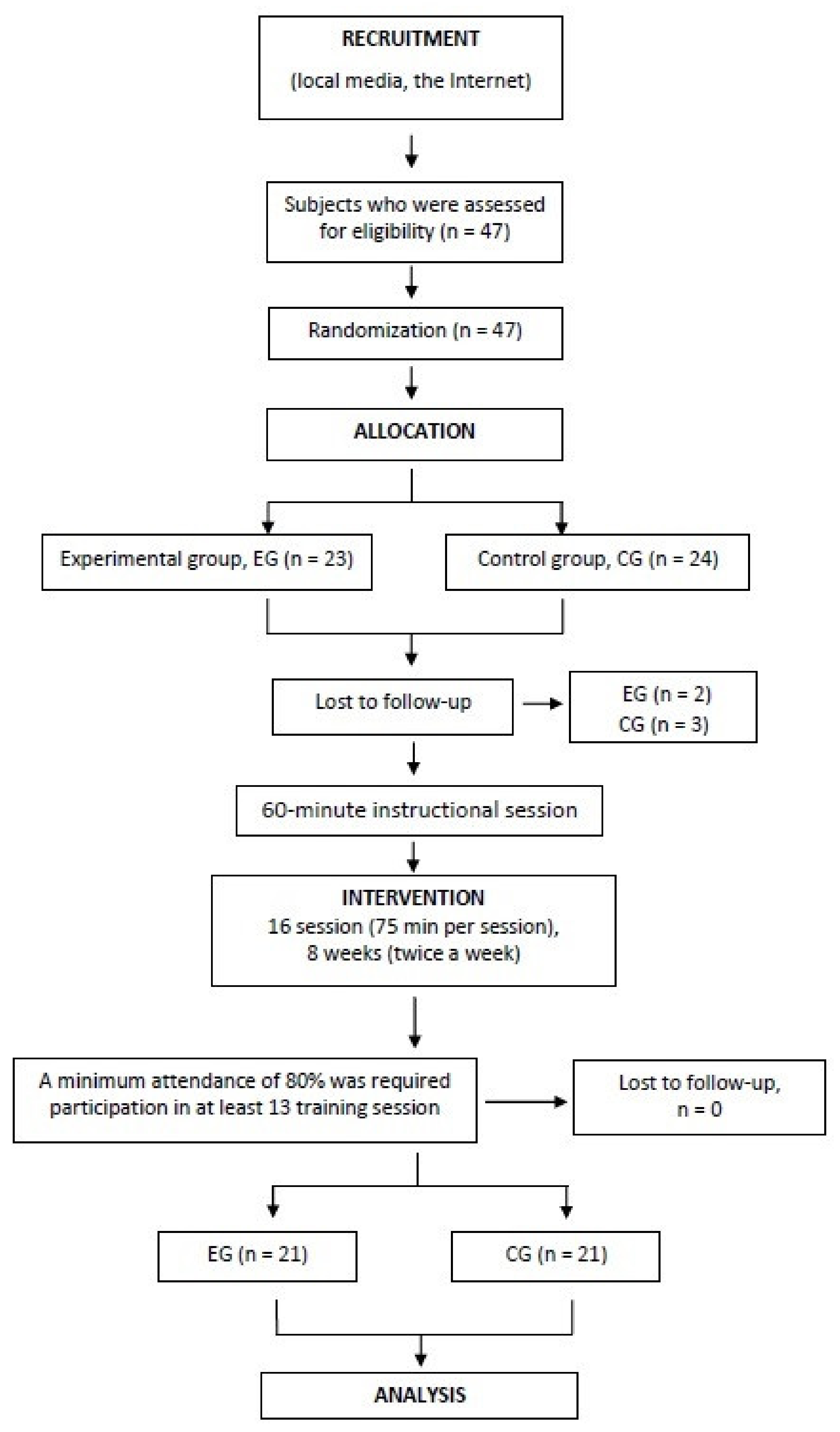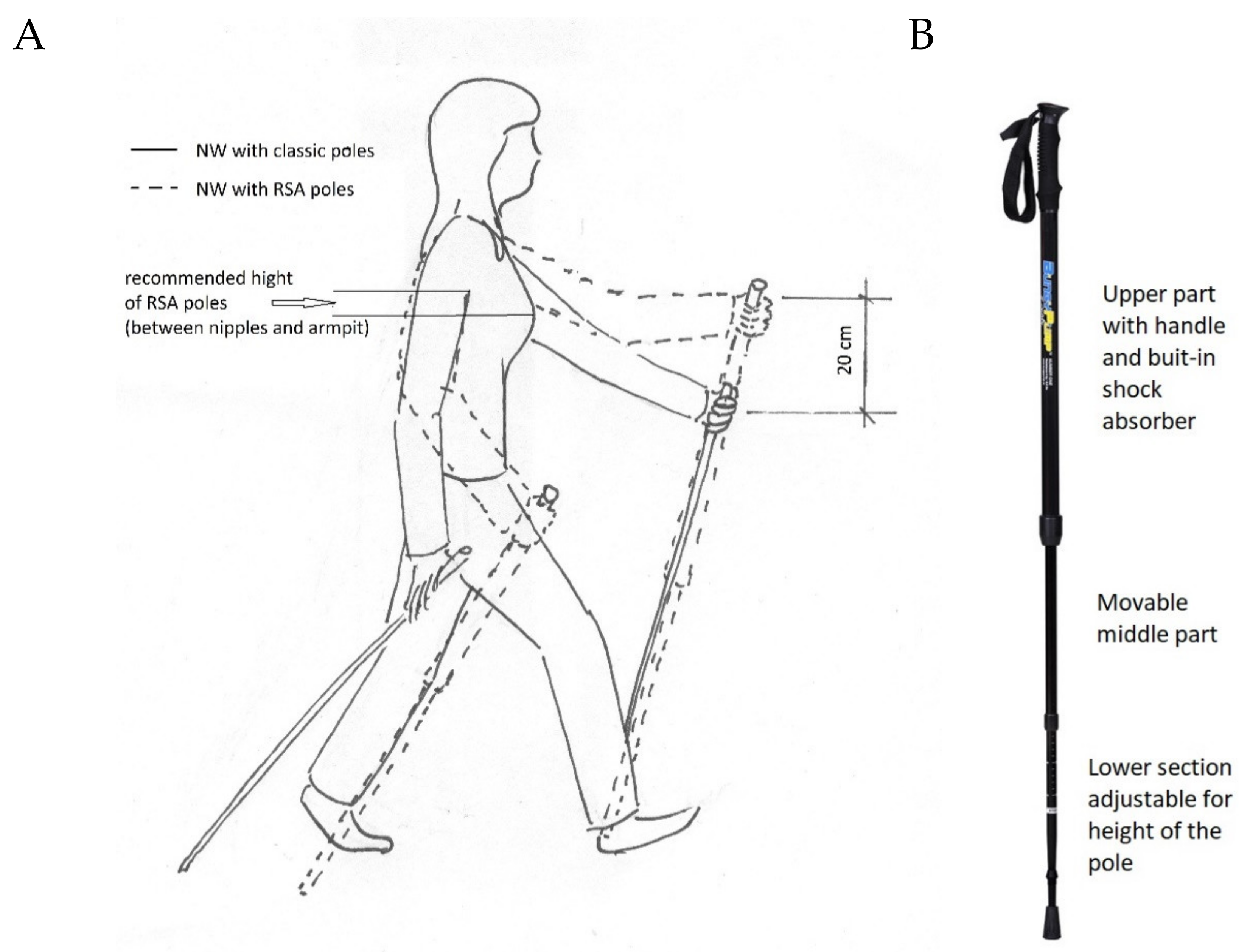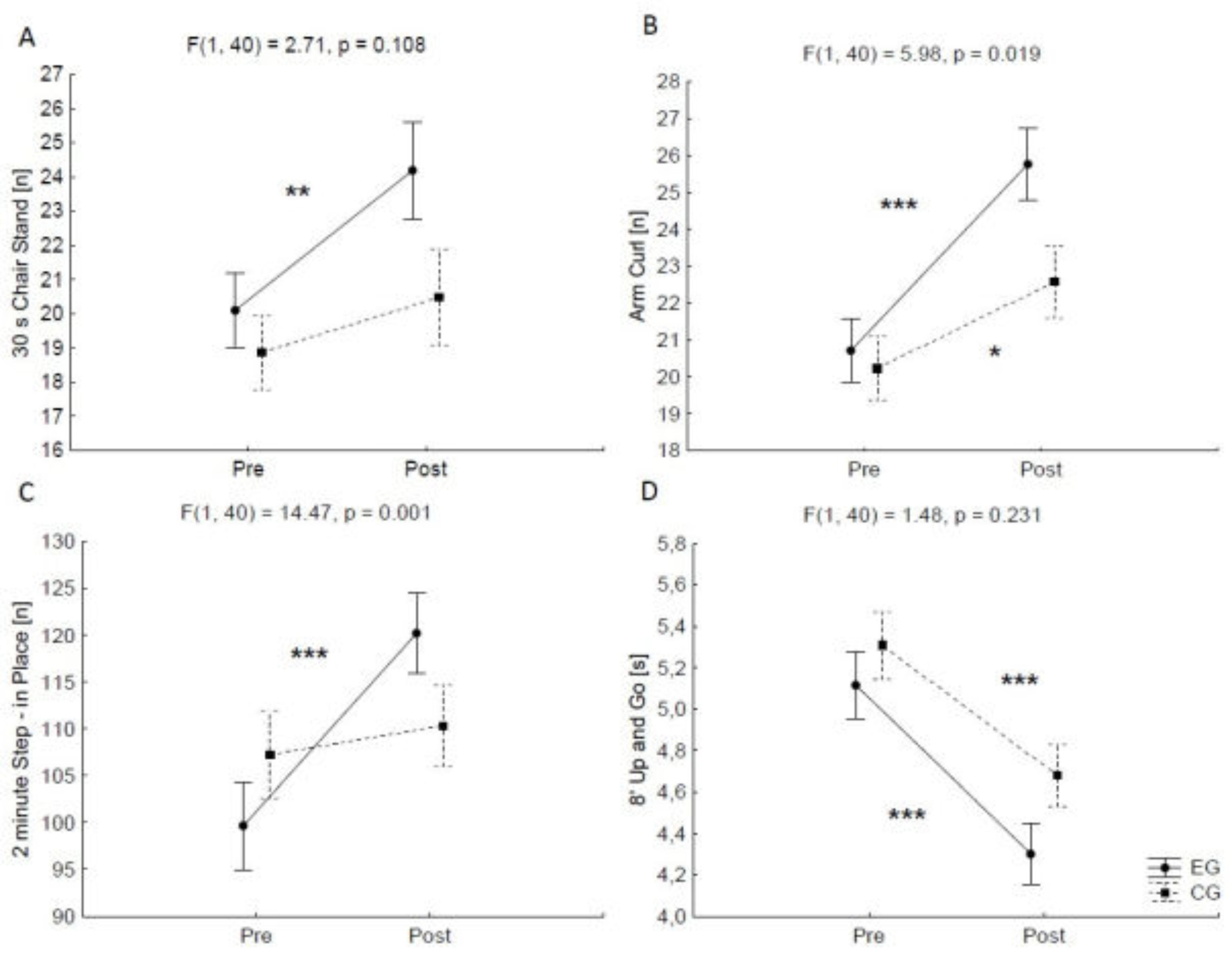The Effect of Nordic Walking Training with Poles with an Integrated Resistance Shock Absorber on the Functional Fitness of Women over the Age of 60
Abstract
1. Introduction
2. Methods
2.1. Participants
2.2. Procedure
- A.
- The 30-second chair stand test: assessment of the lower body strength needed for walking, climbing stairs, getting up from a chair, etc. The result of the test is the number of full stand-ups from the chair within 30 seconds with upper limbs crossed on the chest.
- B.
- Arm curl test: assessment of upper body strength needed for activities requiring lifting or moving of objects. The result of this test is the number of full bends in the elbow in 30 seconds with a weight of 2.27 kg.
- C.
- The 2-minute step test: estimation of aerobic capacity. The result was the number of full steps taken in place in 2 minutes—the number of right knee repetitions to the required height.
- D.
- The 8-foot up and go test: agility score/dynamic balance level in tasks requiring fast maneuvers such as getting in and out of public transport.
2.3. Statistics
3. Results
4. Discussion
5. Limitations
6. Conclusions
Author Contributions
Funding
Conflicts of Interest
References
- Chodzko-Zajko, W.J.; Proctor, D.N.; Fiatarone Singh, M.A.; Minson, C.T.; Nigg, C.R.; Salem, G.J.; Skinner, J.S. Exercise and physical activity for older adults. Med. Sci. Sports Exerc. 2009, 41, 1523. [Google Scholar] [CrossRef] [PubMed]
- Blair, S.N. Physical inactivity: The biggest public health problem of the 21st century. Br. J. Sports Med. 2009, 43, 1–2. [Google Scholar] [PubMed]
- Jessen, J.D.; Lund, H.H. Study protocol: Effect of playful training on functional abilities of older adults—A randomized controlled trial. BMC Geriatr. 2017, 17, 27. [Google Scholar] [CrossRef] [PubMed]
- Sun, F.; Norman, I.J.; While, A.E. Physical activity in older people: A systematic review. BMC Public Health 2013, 13, 449–466. [Google Scholar] [CrossRef] [PubMed]
- Frew, E.J.; Bhatti, M.; Win, K.; Sitch, A.; Lyon, A.; Pallan, M.; Adab, P. Cost-effectiveness of a community-based physical activity programme for adults (Be Active) in the UK: An economic analysis within a natural experiment. Br. J. Sports Med. 2014, 48, 207–212. [Google Scholar] [CrossRef] [PubMed]
- Kilingback, C.; Tsofliou, F.; Clark, C. Older people’s adherence to community-based group exercise programmes: A multiple-case study. BMC Public Health 2017, 17, 115. [Google Scholar] [CrossRef]
- Beaudart, C.; Reginster, J.Y.; Petermans, J.; Gillain, S.; Quabron, A.; Locquet, M.; Slomian, J.; Buckinx, F.; Bruyère, O. Quality of life and physical components linked to sarcopenia: The SarcoPhAge study. Exp. Gerontol. 2015, 69, 103–110. [Google Scholar] [CrossRef]
- Fougere, B.; Vellas, B.; van Kan, G.A.; Cesari, M. Identification of biological markers for better characterization of older subjects with physical frailty and sarcopenia. Transl. Neurosci. 2015, 6, 103–110. [Google Scholar] [CrossRef]
- Tschentscher, M.; Niederseer, D.; Niebauer, J. Health benefits of Nordic walking: A systematic review. Am. J. Prev. Med. 2013, 44, 76–84. [Google Scholar] [CrossRef] [PubMed]
- Ossowski, Z.M.; Skrobot, W.; Aschenbrenner, P.; Cesnaitiene, V.J.; Smaruj, M. Effects of short-term Nordic walking training on sarcopenia-related parameters in women with low bone mass: A preliminary study. Clin. Interv. Aging 2016, 11, 1763–1771. [Google Scholar] [CrossRef]
- Sánchez-Sánchez, J.L.; Mañas, A.; García-García, F.J.; Ara, I.; Carnicero, J.A.; Walter, S.; Mañas, L.R. Sedentary behaviour, physical activity, and sarcopenia among older adults in the TSHA: Isotemporal substitution model. J. Cachexia Sarcopenia Muscle 2019, 10, 188–198. [Google Scholar] [CrossRef] [PubMed]
- Evans, W.J. Skeletal muscle loss: Cachexia, sarcopenia and inactivity. Am. J. Clin. Nutr. 2010, 91, 1123–1127. [Google Scholar] [CrossRef] [PubMed]
- Montero-Fernández, N.; Serra-Rexach, J.A. Role of exercise on sarcopenia in the elderly. Eur. J. Phys. Rehabil. Med. 2013, 49, 131–143. [Google Scholar] [PubMed]
- Martins, R.A.; Coelho-e-Silva, M.J.; Pindus, D.M.; Verissimo, M.T. Effects of strength and aerobic-based training on functional fitness, mood and the relationship between fatness and mood in older adults. J. Sports Med. Phys. Fit. 2011, 51, 489–496. [Google Scholar] [CrossRef]
- Sherrington, C.; Whitney, J.C.; Lord, S.R.; Herbert, R.D.; Cumming, R.G.; Close, J.C. Effective exercise for the prevention of falls: A systematic review and meta-analysis. J. Am. Geriatr. Soc. 2008, 56, 2234–2243. [Google Scholar] [CrossRef]
- Clemson, L.; Singh, M.F.; Bundy, A.; Cumming, R.G.; Weissel, E.; Munro, J.; Manollaras, K.; Black, D. LIFE Pilot Study: A randomised trial of balance strenght training embedded in daily life activity to reduce falls in older adults. Aust. Occup. Ther. J. 2010, 57, 42–50. [Google Scholar] [CrossRef]
- Ramsbottom, R.; Ambler, A.; Potter, J.; Jordan, B.; Nevill, A.; Wiliams, C. The effect of 6 months training on leg power, balance, and functional mobility of independently living adults over 70 years old. J. Aging Phys. Act. 2004, 12, 497–510. [Google Scholar] [CrossRef]
- Martone, A.M.; Marzetti, E.; Calvani, R.; Picca, A.; Tosato, M.; Santoro, L.; Di Giorgio, A.; Nesci, A.; Sisto, A.; Landi, F.; et al. Exercise and protein intake: A synergistic approach against sarcopenia. BioMed Res. Int. 2017, 2017, 2672435. [Google Scholar] [CrossRef]
- Takeshima, N.; Islam, M.M.; Rogers, M.E.; Rogers, N.L.; Sengoku, N.; Koizumi, D.; Kitabayashi, Y.; Imai, A.; Naruse, A. Effects of nordic walking compared to conventional walking and band-based resistance exercise on fitness in older adults. J. Sport Sci. Med. 2013, 12, 422–430. [Google Scholar]
- Lee, H.S.; Park, J.H. Effects of Nordic walking on physical functions and depression in frail people aged 70 years and above. J. Phys. Ther. Sci. 2015, 27, 2453–2456. [Google Scholar] [CrossRef]
- Parkatti, T.; Perttunen, J.; Wacker, P. Improvementsin functional capacity from nordic Walking: A randomized-controlled trial among elderly people. J. Aging Phys. Act. 2012, 20, 93–105. [Google Scholar] [CrossRef] [PubMed]
- Oesen, S.; Halper, B.; Hofmann, M.; Jandrasits, W.; Franzke, B.; Strasser, E.M. Effects of elastic band resistance training and nutritional supplementation on physical performance of institutionalised elderly—A randomized controlled trial. Exp. Gerontol. 2015, 72, 99–108. [Google Scholar] [CrossRef] [PubMed]
- Cadore, E.L.; Izquierdo, M. How to simultaneously optimize muscle strength, power, functional capacity, and cardiovascular gains in the elderly: An update. Age 2013, 35, 2329–2344. [Google Scholar] [CrossRef]
- Rikli, R.E.; Jones, C.J. Development and validation of a functional fitness test for community-residing older adults. J. Aging Phys. Act. 1999, 7, 129–161. [Google Scholar] [CrossRef]
- Virag, A.; Karoczi, C.K.; Jakab, Á.; Vass, Z.; Kovács, É.; Gondos, T. Short- term and long-term effects of nordic walking on balance, functional mobility, muscle strength and aerobic endurance among Hungarian community-living older people: A feasibility study. J. Sports Med. Phys. Fit. 2015, 55, 1285–1292. [Google Scholar]
- Bieler, T.; Siersma, V.; Magnusson, S.P.; Kjaer, M.; Christensen, H.E.; Beyer, N. In hip osteoarthritis, Nordic Walking is superior to strength trening and home based exercise for improving function. Scand. J. Med. Sci. Sports 2017, 27, 873–886. [Google Scholar] [CrossRef]
- Todde, F.; Melis, F.; Mura, R.; Pau, M.; Fois, F.; Magnani, S.; Ibba, G.; Crisafulli, A.; Tocco, F. A 12-Week Vigorous Exercise Protocol in a Healthy Group of Persons over 65: Study of Physical Function by means of the Senior Fitness Test. BioMed Res. Int. 2016, 2016. [Google Scholar] [CrossRef]
- Belza, B.; Shumway Cook, A.; Phelan, E.A.; Williams, B.; Snyder, S.J.; LoGerfo, J.P. The Effects of a Community-Based Exercise Program on Function and Health in Older Adults: The Enhance Fitness Program. J. Appl. Gerontol. 2006, 25, 291–306. [Google Scholar] [CrossRef]
- Keogh, J.; Rice, J.; Taylor, D.; Kilding, A. Objective benefits, participant perceptions and retention rates of a New Zealand community-based, older-adult exercise programme. J. Prim. Health Care 2014, 6, 1172–6164. [Google Scholar] [CrossRef]
- Holviala, J.; Kraemer, W.J.; Sillanpää, E.; Karppinen, H.; Avela, J.; Kauhanen, A.; Häkkinen, A.; Häkkinen, K. Effects of strength, endurance and combined training on muscle strength, walking speed and dynamic balance in aging men. Eur. J. Appl. Physiol. 2012, 112, 1335–1347. [Google Scholar] [CrossRef]
- Ozaki, H.; Kitada, T.; Nakagata, T.; Naito, H. Combination of body mass-based resistance training and highintensity walking can improve both muscle size and VO2 peakin untrained older women. Geriatr. Gerontol. Int. 2017, 17, 779–784. [Google Scholar] [CrossRef] [PubMed]
- Garber, C.E.; Blissmer, B.; Deschenes, M.R.; Franklin, B.A.; Lamonte, M.J.; Lee, I.M.; Swain, D.P. Quantity and Quality of Exercise for Developing and Maintaining Cardiorespiratory, Musculoskeletal, and Neuromotor Fitness in Apparently Healthy Adults: Guidance for Prescribing Exercise. Med. Sci. Sports Exerc. 2011, 1334–1359. [Google Scholar] [CrossRef] [PubMed]
- Shi, L.; Duan, F.; Yang, Y.; Sun, Z. The Effect of Treadmill Walking on Gait and Upper Trunk through Linear and Nonlinear Analysis Methods. Sensors 2019, 19, 2204. [Google Scholar] [CrossRef] [PubMed]
- Schlicht, J.; Camaione, D.N.; Owen, S.V. Effect of intense strength training on standing balance, walking speed, and sit-to-stand performance in older adults. J. Gerontol. Ser. A: Biol. Sci. Med Sci. 2001, 56, 281–286. [Google Scholar] [CrossRef]
- Song, M.S.; Yoo, Y.K.; Choi, C.H.; Kim, N.C. Effects of nordic walking on body composition, muscle strength, and lipid profile in elderly women. Asian Nurs. Res. 2013, 7, 1–7. [Google Scholar] [CrossRef]




| EG (n = 21) | CG (n = 21) | |||
|---|---|---|---|---|
| Measure | M | SD | M | SD |
| Age (years) | 64.24 | 2.86 | 65.14 | 3.43 |
| Body height (cm) | 160.57 | 4.80 | 160.57 | 7.36 |
| Body weight (kg) | 71.90 | 11.52 | 66.57 | 9.89 |
| BMI (kg/m2) | 27.86 | 4.10 | 25.84 | 3.56 |
© 2020 by the authors. Licensee MDPI, Basel, Switzerland. This article is an open access article distributed under the terms and conditions of the Creative Commons Attribution (CC BY) license (http://creativecommons.org/licenses/by/4.0/).
Share and Cite
Marciniak, K.; Maciaszek, J.; Cyma-Wejchenig, M.; Szeklicki, R.; Maćkowiak, Z.; Sadowska, D.; Stemplewski, R. The Effect of Nordic Walking Training with Poles with an Integrated Resistance Shock Absorber on the Functional Fitness of Women over the Age of 60. Int. J. Environ. Res. Public Health 2020, 17, 2197. https://doi.org/10.3390/ijerph17072197
Marciniak K, Maciaszek J, Cyma-Wejchenig M, Szeklicki R, Maćkowiak Z, Sadowska D, Stemplewski R. The Effect of Nordic Walking Training with Poles with an Integrated Resistance Shock Absorber on the Functional Fitness of Women over the Age of 60. International Journal of Environmental Research and Public Health. 2020; 17(7):2197. https://doi.org/10.3390/ijerph17072197
Chicago/Turabian StyleMarciniak, Katarzyna, Janusz Maciaszek, Magdalena Cyma-Wejchenig, Robert Szeklicki, Zuzanna Maćkowiak, Dorota Sadowska, and Rafał Stemplewski. 2020. "The Effect of Nordic Walking Training with Poles with an Integrated Resistance Shock Absorber on the Functional Fitness of Women over the Age of 60" International Journal of Environmental Research and Public Health 17, no. 7: 2197. https://doi.org/10.3390/ijerph17072197
APA StyleMarciniak, K., Maciaszek, J., Cyma-Wejchenig, M., Szeklicki, R., Maćkowiak, Z., Sadowska, D., & Stemplewski, R. (2020). The Effect of Nordic Walking Training with Poles with an Integrated Resistance Shock Absorber on the Functional Fitness of Women over the Age of 60. International Journal of Environmental Research and Public Health, 17(7), 2197. https://doi.org/10.3390/ijerph17072197







